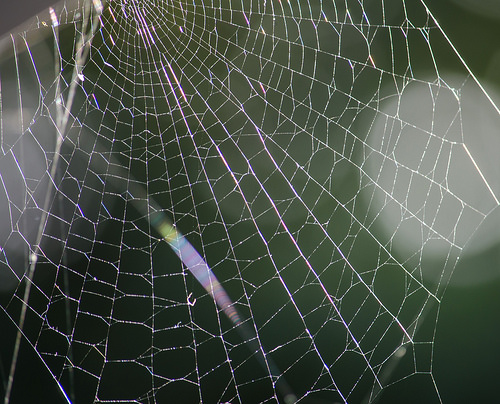As we began discussing learning theories in class last week, I felt as though I had time warped back into my undergrad days. At that point in my learning, I was all about taking in whatever my professors taught me and spewing out the rainbow of knowledge given to me to earn the necessary grade.
 Photo Credit: Tanya Dawn Flickr via Compfight cc
Photo Credit: Tanya Dawn Flickr via Compfight cc
I didn’t really contemplate my own thoughts or views on learning theories or how that would impact my future teaching/students in the classroom. I was still the student and hadn’t thought much about what I believed about how people (namely my students) learn.
As I entered the classroom as a beginning teacher, learning theories were the farthest thing from my mind. Juggling the responsibilities of teaching was too overwhelming at that point to analyze my beliefs about learning. In addition, I had great misconceptions about what the classroom/students would be like or what I would be able to accomplish as a teacher. Most days included deep breaths, hopes of survival and hopefully a few glimpses of learning.
Over the last 13 years of teaching, I have grown from a learner to an educator to an educated learner (as a grad student!) and although I am constantly learning, I feel as though I have a better grasp on my perceptions of learning theories.
As many of my classmates have alluded to I believe learning is complicated and to use Nicole’s words – messy. In Behaviorism, Cognitivism, Constructivism: Comparing Critical Features From an Instructional Design Perspective Ertmer and Newby state
Learning is a complex process that has generated numerous interpretations and theories of how it is effectively accomplished.
Numerous theories and interpretations suggest there isn’t one correct or definitive way. I believe I ascribe to many theories depending on the situation and the learner. I don’t hold to a positivist philosophy of life where there is only one way to know and one absolute to seek. My teaching maneuvers around multiple theories. For example, as Heidi alluded to in her blog post, I lean toward the behaviourist side of learning as I teach my students to respond to protocols and procedures. In this capacity, I believe in stimulus and response. In addition, as I assess my students’ reading levels, I function as a behaviourist as I determine at what point to begin instruction to meet individual needs. However, in other capacities which require deeper critical thinking and understanding, I believe the learner should be an active participant in learning and create meaning within experience – ideas based in both cognitivism and constructivism.
In addition, I enjoyed Siemens’ article on Connectivism. I believe we must be cognizant of how learning and our learners have changed. The influence of technology and the digital age cannot be dismissed as we think about how students learn, how access to knowledge has changed and how technology is altering our brains. I believe we must understand that learning begins at the place of the learner.
So – in my opinion, the webs of learning theories interweave …

Photo Credit: Ken Whytock Flickr via Compfight cc
Much of my beliefs about teaching and learning stem from trying to determine what it is and who it is I am trying to teach. Am I a teacher of curricula? A teacher of people? A teacher of critical thinking? A teacher of responsibility? A teacher of life? A teacher of the digital age? A teacher of ethics? Perhaps this seems to be a little far reaching, but I believe that my job far exceeds the curriculum. I am teacher of a whole child – my teaching only reaches the content of curricula once I have established that I am a child is safe and belongs and that I am trustworthy and have the child’s best interests in mind (Maslow). I must intercept each child where he/she is at …. in learning, in circumstance, in social situations, etc.
Each student has such unique schema. Each student’s understanding and experiences dictate much about how he/she will learn. I need to respect that space and understand each student’s reality in order to create and foster an environment where learning will occur.
Lastly, I am a social constructivist. I believe that much of our learning lies in how we engage with others and create understanding in the world around us. Our interactions create a new dynamic for learning. Last week during our class, Alec stated that “By participating together, our understanding becomes socially constructed.” I love that and I agree that our learning is grounded in our experiences and with others. I think that the complicated outworkings of learning and learning theories is beautiful as we try our best to understand people and the way that we learn together.

Photo Credit: Doolallyally Flickr via Compfight cc
The interweaving webs of learning illustrate beauty in the diversity of our learners.
What do you believe about learning related to the situational perspective and diversity of the learner?

Great post Natalie. I agree that learners will respond differently to different learning strategies, and it is important to meet the learner where he/she is at. Not being a classroom teacher, I wonder how difficult it is to adjust your teaching style for individual students when you have a full class of children with diverse needs. Do you find that you can cater to individual students’ needs, or do you just use a variety of strategies in your teaching to ensure that every learner’s needs are met some of the time?
LikeLike
I certainly can’t cater to each child’s learning needs all the time – I wish! I try my best to meet each child where he/she is at – sometime this means beyond the scope of class time and sometimes this means varying my approach.
LikeLiked by 1 person